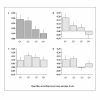Low serum amylase in association with metabolic syndrome and diabetes: A community-based study
- PMID: 21496338
- PMCID: PMC3102610
- DOI: 10.1186/1475-2840-10-34
Low serum amylase in association with metabolic syndrome and diabetes: A community-based study
Abstract
Background: Low serum amylase levels may reflect impaired exocrine-endocrine relationship in the pancreas. However, few clinical studies have addressed this issue. Therefore, in this epidemiological study, we investigated whether low serum amylase was associated with the pathogenesis of impaired insulin action: metabolic syndrome (MetS) and diabetes.
Research design and methods: Serum amylase, cardiometabolic risk factors, MetS (Adult Treatment Panel III criteria), and diabetes were examined in 2,425 asymptomatic subjects aged 30-80 years who underwent medical checkups recently (April 2009-March 2010) and 5 years ago.
Results: Clinical variables, except for age and estimated glomerular filtration rate (eGFR), shifted favorably with increasing serum amylase levels. Plasma glucose levels at 1- and 2-hr during OGTT increased significantly with decreasing serum amylase levels. Multiple logistic analyses showed that, compared with highest quartile of serum amylase, lowest quartile was associated with increased risk for MetS and diabetes after adjustment for confounding factors [odds ratio (95% CI), 2.07 (1.39-3.07) and 2.76 (1.49-5.11), respectively]. In subjects who underwent checkups 5 years ago (n = 571), lower amylase at the previous checkup were associated with larger numbers of metabolic abnormalities at the recent checkup. The fluctuation over time in serum amylase levels in subjects with low serum amylase at the previous checkup was slight and was unaffected by kidney dysfunction.
Conclusions: Our results indicate that low serum amylase is associated with increased risk of metabolic abnormalities, MetS and diabetes. These results suggest a pancreatic exocrine-endocrine relationship in certain clinical conditions.
Figures




References
-
- Skrha J, Stĕpán J. Clinical significance of amylase isoenzyme determination. Acta Univ Carol Med Monogr. 1987;120:1–81. - PubMed
-
- Pieper-Bigelow C, Strocchi A, Levitt MD. Where does serum amylase come from and where does it go? Gastroenterol Clin North Am. 1990;19:793–810. - PubMed
-
- Kjaergaard JJ, Salling N, Magid E, Ditzel J. Serum amylase during recovery from diabetic ketoacidosis. Diabete Metab. 1984;10:25–30. - PubMed
-
- Junge W, Mályusz M, Ehrens HJ. The role of the kidney in the elimination of pancreatic lipase and amylase from blood. J Clin Chem Clin Biochem. 1985;23:387–392. - PubMed
MeSH terms
Substances
LinkOut - more resources
Full Text Sources
Other Literature Sources
Medical
Research Materials
Miscellaneous

